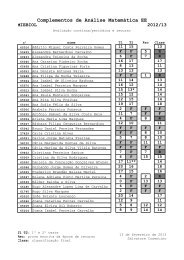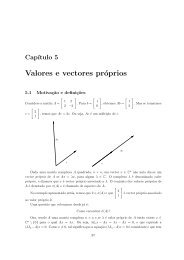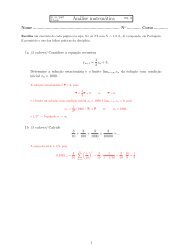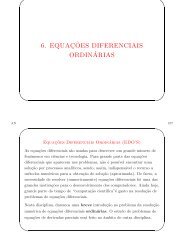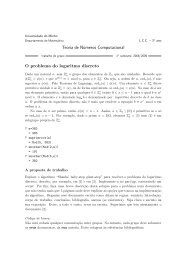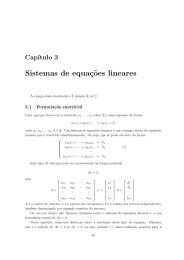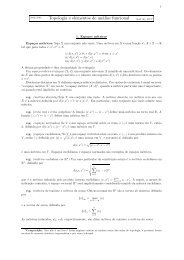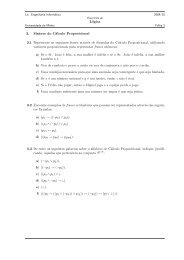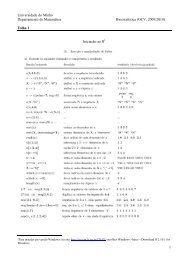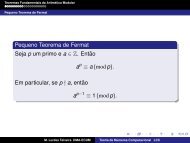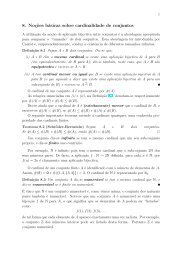My title - Departamento de Matemática da Universidade do Minho
My title - Departamento de Matemática da Universidade do Minho
My title - Departamento de Matemática da Universidade do Minho
Create successful ePaper yourself
Turn your PDF publications into a flip-book with our unique Google optimized e-Paper software.
6 FLOWS 39<br />
6 Flows<br />
“... forse stima che la filosofia sia un libro e una fantasia d’un uomo, come l’Ilia<strong>de</strong> e<br />
l’Orlan<strong>do</strong> furioso, libri ne’ quali la meno importante cosa è che quello che vi è scritto<br />
sia vero. Signor Sarsi, la cosa non istà così. La filosofia è scritta in questo grandissimo<br />
libro che continuamente ci sta aperto innanzi agli occhi (io dico l’universo), ma non si<br />
può inten<strong>de</strong>re se prima non s’impara a inten<strong>de</strong>r la lingua, e conoscer i caratteri, ne’<br />
quali è scritto. Egli è scritto in lingua matematica, e i caratteri son triangoli, cerchi,<br />
ed altre figure geometriche, senza i quali mezi è impossibile a inten<strong>de</strong>rne umanamente<br />
parola; senza questi è un aggirarsi vanamente per un oscuro laberinto.”<br />
6.1 Structure of physical mo<strong>de</strong>ls<br />
Galileo Galilei, Il saggiatore, 1623.<br />
Flows of vector fields. The main way in which dynamical systems enter in physics is through<br />
differential equations. Let X be a differentiable manifold, and let v be a vector field on X. If we<br />
assume that the autonomous differential equation<br />
ẋ = v(x)<br />
with any given initial condition x (0) = x, has solutions t ↦→ x (t) which exist for any time t ∈ R<br />
(as is the case when v is smooth and X is compact), then the flow of v is the action Φ : R×X → X<br />
given by Φ t (x) = x (t).<br />
From flows to maps. Given a flow Φ : R×X → X, one could specialize to discrete time looking<br />
at the system at multiples integers nτ of a given time-unit τ > 0, and this amounts to iterate the<br />
transformation f = Φ τ .<br />
Also, given a submanifold U ⊂ X of codimension 1 which is transversal to the flow (i.e. the<br />
tangent space T x U is transversal to Rv(x) for any x ∈ U), one could <strong>de</strong>fine a first return map<br />
f : U → U sending a point x ∈ U into x(t) if t is the smallest positive time t > 0 such that<br />
Φ t (x) ∈ U.<br />
Newtonian mechanics. According to greeks, the “velocity” ˙q = d dtq of a planet, where<br />
q ∈ R 3 is its position in our eucli<strong>de</strong>an space and t is time, was <strong>de</strong>termined by gods or whatever<br />
forced planets to move around circles. Then came Galileo, and showed that gods could at most<br />
<strong>de</strong>termine the “acceleration” ¨q = d2<br />
dt<br />
q, since the laws of physics should be written in the same<br />
2<br />
way by an observer in any reference system at uniform rectilinear motion with respect to the fixed<br />
stars. Finally came Newton, who <strong>de</strong>ci<strong>de</strong>d that what gods <strong>de</strong>termined was to be called “force”,<br />
and discovered that the trajectories of planets, fulfilling Kepler’s experimental three laws 10 , were<br />
solutions of his famous (second or<strong>de</strong>r differential) equation<br />
m¨q = F<br />
where m is the mass of the planet, and where the attractive force F between the planet and the<br />
Sun is proportional to the product of their masses and inverse proportional to the square of their<br />
distance.<br />
Later, somebody noticed that most observed forces were “conservative”, could be written as<br />
F = −∇V , for some real valued function V (q) called “potential energy”. There follows that<br />
Newton equations can be written as m¨q = −∇V , and that the “total energy”<br />
E = 1 2 m | ˙q|2 + V (q)<br />
10 In Astronomia nova, 1609, and Harmonices mundi, 1619, Johannes Kepler published his three laws of planetary<br />
motions:<br />
i) planets moves in ellipses with focus at the Sun,<br />
ii) the radius vector <strong>de</strong>scribes equal areas in equal times,<br />
iii) the squares of the periods are to each other as the cubes of the mean distance from the Sun.<br />
It was with the purpose to <strong>de</strong>rive Kepler laws from a second or<strong>de</strong>r differential equation m¨q = F that Isaac Newton<br />
realized that the force of gravitational attraction between the Sun and a planet (hence between any two bodies!)<br />
should be proportional to m/ρ 2 (Philosophiae naturalis principia mathematica, 1687).



